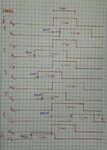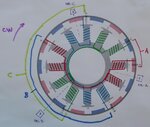righteous
Full Member level 2
Gents,
Getting back to my running BLDC, I looked at the timing of the hi and low drivers, it is amazing that thing is spinning around the way the signals are out of alignment, so I would like to get the timing in order so that it may run top efficient.
This is the hand made timing diagram of the hi and low of the three half bridges:

I notice that the B-hi and B-low are both 1.5ms in duration, whereas A and C are both 1.1ms, so why the h... is that? Is that a misalignment of one hall sensor?
Otherwise ABC-low signals are all over the place, I can't see any pattern in it that would give a hint to what the problem might be.
The controller is implemented with a PIC 16F1933 and the code is adapted from AN857 Brushless DC Motor Control Made Easy (yeah right ...'easy'... however the free running Timer0 is a masterpiece, but annoying - I would prefer to do it with interrupts, but I need to get the timing right first)
Getting back to my running BLDC, I looked at the timing of the hi and low drivers, it is amazing that thing is spinning around the way the signals are out of alignment, so I would like to get the timing in order so that it may run top efficient.
This is the hand made timing diagram of the hi and low of the three half bridges:

I notice that the B-hi and B-low are both 1.5ms in duration, whereas A and C are both 1.1ms, so why the h... is that? Is that a misalignment of one hall sensor?
Otherwise ABC-low signals are all over the place, I can't see any pattern in it that would give a hint to what the problem might be.
The controller is implemented with a PIC 16F1933 and the code is adapted from AN857 Brushless DC Motor Control Made Easy (yeah right ...'easy'... however the free running Timer0 is a masterpiece, but annoying - I would prefer to do it with interrupts, but I need to get the timing right first)







